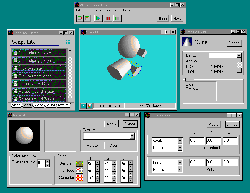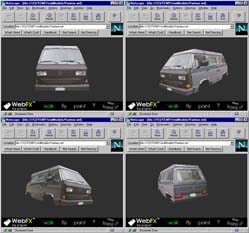Note: If you notice that your VRML viewer/Web browser (for example, Netscape and WebFX or WIRL) crashes while accessing certain pages or WRL files, we might have a solution. The problem may be related to the use of EMBED tags. The alpha release of WIRL doesn't handle them well at all, and they apparently cause instability in WebFX, as well. Try quickly copying the URL (from any link to a VRML file) on a page to the clipboard before the embedded WRL files load, quit and restart Netscape and paste it into the location bar to access the URL directly (i.e., don't access it from the page that causes the crash). We've managed to load VRML files that otherwise crash Netscape and WebFX this way; perhaps it will solve your problems, too.
Since the last issue, VRML innovations are coming fast and furious. Here are the latest updates:
We recently reported that ParaGraph had apparently removed the free unsupported beta version of its Virtual Home Space Builder from its Web site. However, after talking to a company spokesperson, it turns out that the free unsupported beta is still there, at www.paragraph.com, along with a save-disabled version of the US$495 Commercial/$49.95 "Personal use" program, and a bunch of other free stuff, including textures, models, and other goodies. We were equally delighted to see that the company mentions this site at its location. (We used VHSB to create the Virtual PC and VMART projects located elsewhere on this site). Paragraph has also posted what it calls the first RealAudio-enhanced Home Space in VRML, the so-called "Gourd CD Hall." Send Paragraph your comments about this "Gourd CD Hall," and tell them you read about it on The Computer Paper's VRML News page!
 Jan. 29th, Sony released the beta 2 version of Cyber Passage, a VRML browser
(3.5MB) and Cyber Passage Conductor, a VRML authoring tool (8.5MB!).
Both tools require Windows 95.
Jan. 29th, Sony released the beta 2 version of Cyber Passage, a VRML browser
(3.5MB) and Cyber Passage Conductor, a VRML authoring tool (8.5MB!).
Both tools require Windows 95.
We found Cyber Passage Conductor to be very fast and full-featured. It supports textures and proprietary extensions such as embedded audio and animations. The interface makes elegant use of Windows 95 drag-and-drop functions -- very cool.
Also on Jan. 29th, Caligari released beta 5 of its free Fountain web authoring software -- still our chosen VRML editing environment. Beta 5 features animated help (at least for some tools), improved speed and a neat 3-D bookmarks feature. A few lucky beta testers got a peek at the first beta release of Fountain Pro this week, as well.
Jan. 28 saw the release of VREAM's WIRL, a phenomenal new interactive 3D web browser plug-in for Netscape 2.0 and Windows 95. Stroud's review is here. This is an amazing advance in VRML -- we signed up to buy the authoring package on the spot after seeing the demos. Don't miss it. It's really hot. The authoring package is on special until Jan.31st, incidentally.
 Jan. 25th - Eos
Systems of Vancouver, B.C. has officially released the new 2.1
upgrade to its Photomodeler program, which can take photographs
and turn them into a 3-D model with surprising ease. The upgrade creates
photo-realistic VRML files from color or B&W photographs -- almost
automatically. We worked with a release version of the program on a P90
with 16MB RAM and found it to be trouble-free on both Windows 3.x and Windows
95. In the few hours we've spent with the program, we successfully created
several .WRL files with wraparound JPEG texture maps that made for amazingly
lifelike models. (Some VRML samples are here.)
Jan. 25th - Eos
Systems of Vancouver, B.C. has officially released the new 2.1
upgrade to its Photomodeler program, which can take photographs
and turn them into a 3-D model with surprising ease. The upgrade creates
photo-realistic VRML files from color or B&W photographs -- almost
automatically. We worked with a release version of the program on a P90
with 16MB RAM and found it to be trouble-free on both Windows 3.x and Windows
95. In the few hours we've spent with the program, we successfully created
several .WRL files with wraparound JPEG texture maps that made for amazingly
lifelike models. (Some VRML samples are here.)
The company calls Photomodeler "The world's easiest way to create realistic photo-textured 3D VRML models for the Web," and we're inclined to agree. Basically, you have to line up a perspective box with each of the photos you have taken (35mm, video-capture and digital cameras are supported), then correlate points from one "reference" photo with corresponding points on the other photos. Although the company says two photos is the minimum amount necessary to create these references, we found four photos to be a more practical amount.
The program can output a DXF file of the resultant model, but we think its best feature is its ability to create fully texture-mapped VRML files that look great in WebFX and other viewers. (Interestingly, we found that the Chaco VRScout 1.2 viewer took inordinately long to load the files; version 1.22 seems to have fixed the apparent incompatibility between Photomodeler and VRScout.) More info on Photomodeler is here.
Chaco Communications has released another upgrade to its VRScout plug-in for Netscape 2.0. VRScout 1.22, according to company spokesperson Dan R. Greening, now supports (illegal but common) multiple top level nodes, does away with EOF messages, and is no longer touchy about Paper's extensions. VR Scout 1.22, released Jan. 23, 1996 does not support Paper's proprietary VRML language extensions, but at least it doesn't fail to load files because of them.
Says Greening, "We are now down to maybe a single flaw we know about, identified by Mitra's test page."
Also, VRScout is no longer slower on complex models than Microsoft VE. (According to Greening, this was caused by doing too many polys on distant spheres and cones, a situation that is now fixed.)
DimensionX has been creating a bit of a stir with its Liquid Reality Java-enabled VRML browser, and on Jan. 15th released a public beta of a steaming animation utility that allows animations to be played as they are downloading. We wish Macromedia ShockWave could do this.... (Beta 2 of ShockWave for Windows was released in mid-January, and a barely-stable Mac version is there now, too.)
We've also had an advance look at an impressive US$49 animation utility called Scream from Toronto, ON-based ScreamTek that creates amazingly small 2-D animation-and-sound files ideally suited for use on the Web. The company says Netscape 2.0 plug-ins for Windows and Mac are coming.
Jan. 15th marked the release of a new alpha version (a145) of Virtus Voyager, still the only VRML browser in general release for 68K Macs. A Power Mac version (much faster than Whurlwind) is also available, and a Windows 95 version was released Jan. 25th.
ClayWorks is a new offering from the UK that supports VRML, at least in the commercial version. A downloadable version will show you what the package is like.
Eagen Systems still has not released its VRML browser for OS/2, although it presumably won't be long now. (We note that the "Coming Soon" page hasn't been updated since November -- not a particularly encouraging sign.)
A recent MacWeek reports that Apple is touting 3DMF as an "open standard" for VRML, saying it is supported by Macintosh, Windows and Unix machines. Right.
Here is a quote from TidBITs (an online e-zine of interest primarily to Mac users) on Virtus' VRML developments at the recent Macworld in San Francisco:
"Virtus showed off Virtus Voyager, an alpha release VRML browser that currently (in the version I just downloaded) functions as a helper application for Netscape. VRML, Virtual Reality Modeling Language, is used to create three dimensional environments. Voyager enables you to view and navigate VRML documents with fluid links to and from normal Web pages or to and from other VRML documents. Voyager can import files from Virtus WalkThrough Pro 2.5 or from any other 3-D program that can do VRML export..."
The alpha version of Voyager is available for download via the Virtus Web site.
In other Mac-related VRML News, North Plains Systems of Mississauga,
ON, has released VRML
Equinox 1.0a10 for Power Macintosh.
The alpha release, which expires on Feb. 15/96, features a number of
improvements, including:
Paper Software has also upgraded its WebFX browser for improved compatibility with Netscape 2.0 beta 4 or newer versions. A 10k patch or completely new plug-in (revision "E") is available at the company's web site.
Visual Software has released a bug-fix upgrade to its Visual Reality 2.0 software -- possibly one of the best deals on the market, with a hefty 7 CDs full of content for under US$300. The new 2.03 software now creates VRML files complete with textures!
We also had a look at Asymetrix's Web3D package. Surprisingly, the software doesn't support VRML at all. Presumably, the company intends the package -- based on the company's 3DFX title -- to be used for creating GIF and JPEGs to adorn your Web page and little more. Too bad....
Finally, Microsoft has released a "virtual chat" environment for MSN that supports both 2D and 3D graphics. MSN, in case you hadn't heard, became available for no hourly connect time (the monthly or yearly charge still applies) to Internet users when Microsoft released MSN version 1.2 software on Jan. 10th. The company has released version 2.0 of its VRML plug-in, and it is excellent! It solves the problems we noted with both navigation and texture-mapping. It's a worthwhile upgrade, and a serious contender in the VRML arena. In other Microsoft news, the company has also released beta versions of Internet Explorer for Windows 3.1 and Macintosh/Power Macintosh.
Microsoft, which on Jan. 16th, bought Vermeer Technologies and its FrontPage Web authoring tool, says it is sending us a beta of its forthcoming "Blackbird" authoring environment, which reportedly includes 3-D technology from Caligari. Perhaps in the next issue of VRML News, we'll be able to report on this. Stay tuned....
The next issue of VRML News will be posted in early Feb.
Your comments are appreciated!
Go to TCP Online